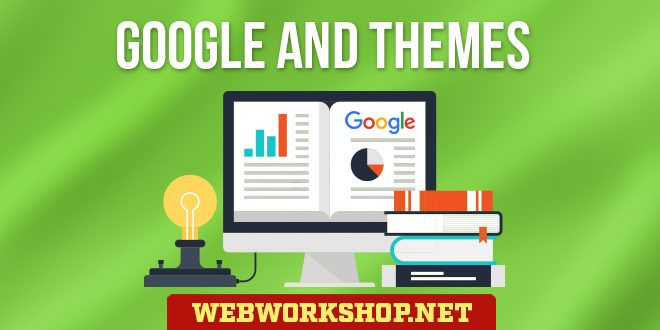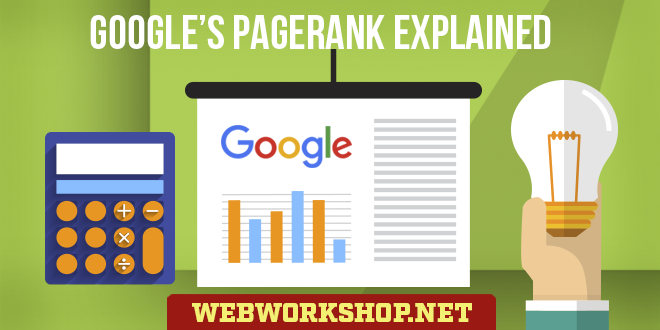In our terms a theme can be many things, such as a color scheme or subject matter, but in Google’s terms, a theme is the subject matter – the topic. The topic is what the web pages are about. A jewelry website’s pages are about jewelry of various kinds, therefore the site’s theme is jewelry. Each page might be about a different kind of jewelry. The theme of a page about bracelets is bracelets and the theme of a page about necklaces is necklaces, but the overall theme of the site is jewelry.
Like many top search engines, Google likes themes to the extent that they influence a page’s rankings. People often wonder why their PR6 page can’t beat a PR4 or PR5 page in the rankings for a particular search term. There are a number of reasons for it and one of them is the theme of the sites or pages.
This site (webworkshop.net) is a good example. At the time of writing this particular page, the site contains only 5 pages, and Google has indexed all 5. There are a few medium PR inbound links to the site and a link to one of the pages from DMOZ. The result is that 4 pages have PR4 and the DMOZ linked page has PR5. It’s a tiny site and yet it beats pages with higher PagRanks on larger sites. Why? Because the whole site is about PageRank. It has just one topic or theme. Even the front page, which isn’t specifically about PageRank, includes the word “PageRank” several times. It isn’t ranked at the very top for the search term “pagerank” (#12 as this is being written) but the ranking could be improved even with such a tiny site as this one. Some competing sites include other topics which dilute their PageRank content or theme. That’s one reason why lower PageRanks sometimes beat higher PageRanks. There are a number of important reason and themes is one of them.
If I were to add a few pages about something completely different, say hotels, then the overall ‘PageRank’ theme of the site would be diluted. It wouldn’t be one thing or the other, and it’s “pagerank” rankings would suffer. Yes, it’s PageRank pages would still be heavily themed but the overall site theme would be diluted. In the jewelry site example, each page is about a different kind of jewelry; necklaces, bracelets, rings, etc. and the overall site theme is jewelery. But it isn’t necklaces! If another site came along that covered only necklaces, it’s theme would be necklaces and for “necklace” type search terms it would have a good chance of beating the jewelry site in the rankings. It would depend on a number of factors, of course, but the theme is one important factor.
Most sites don’t cover one precise topic such as PageRank or necklaces. They tend to cover general topics such as search engine information or jewelry. But there is something we can do to improve the theming in these sites and make the most of their pages’ themes.
Suppose that the jewelry site deals with bracelets, rings and necklaces, and each of its content pages talks about all 3 product groups. What is each page’s theme? What is the site’s them? The product groups have been spread through the site and pages in a sort of generic fashion, so each page would be rather weakly themed towards necklaces, rings and bracelets. None of the 3 product groups would be strong in any of the pages. The site’s theme would be pretty much the same.
Now suppose that the site has a number of pages that only deals with necklaces, another group that only deals with rings, and a group of pages for bracelets. Each page is now strongly themed towards necklaces, rings or bracelets. No dilution occurs in any of the pages, so each of these pages would fair better in the rankings for its particular theme.
Linking and link text
We can go further. By arranging links between the pages in each product group so that necklace pages link to necklace pages, ring pages link to ring pages, etc., and by using the link text properly, we can strengthen the theme of each page.
Google attributes the link text to the page that it is linking to. So the link text, “handmade bracelets”, is attributed to the page that it links to. If the page is about handmade bracelets, the link text strengthens its ‘handmade bracelets’ theme. To see how significant the link text is, a group of people linked many pages to particular target page and all used the same link text phrase. The target page was nothing to do with the link text phrase. It didn’t contain it and it wasn’t about it. Nevertheless, the page made #1 in Google for the link text phrase. The method became known as “Google bombing”.
Summary
So to theme a site that deals with various products, split the site’s pages into various product groups and make links, with the right link text, between the pages in each group. The pages from each group can all be in one directory but I would make a sub-directory for each group and name the directory according to its product. Link from the site’s index page or from a sitemap page to one of the pages in each group. From that page, all the other pages in the group can be found via links between them. If a product group is large enough to contain several sub-products, then split it into sub-products and apply the same idea with them.
Themes and PageRank
This has been about themes. But themes are not the only factor in the rankings. PageRank is the basis of them. To take PageRank into account with the theme structure described, read Google’s PageRank and how to make the most of it, and apply the concepts to the all the linkages within the site, including those within each product group.


